


Committed to Sustainable Cities and Human Settlements for All

In Special Consultative Status with ECOSOC
Abstract: The speaker briefed the basics of the IGMC Initiative and Standards, told what IGMC has done over the past year, shared the background, policy and some cases as well as his advice on the trends of urban planning and development. Today, the three major trends in urban development are "carbon-based greening", "silicon-based Intellectualization" and "people-based inclusiveness", which will fully combine to reshape our cities and communities. The vision of the IGMC is to build cities and human settlements that are characterized by “safety, sustainability, equality, identity, prosperity and happiness”. Taking happiness as the highest value means to follow and lead these trends of urban development. Therefore, to implement the 2030 Agenda for Sustainable Development, the New Urban Agenda and the Paris Agreement at the local level through IGMC Initiative is an important way to achieve the goal of sustainable development for all mankind.
Keywords: International Green Model City, standards, policy, cases, trends, way
On this vigorous spring day, we meet here in Shenzhen, the center of the Guangdong-Hong Kong-Macao Greater Bay Area, for the International Green Model City Forum of the 15th IGEBC, which is also an annual gathering of the IGMC family and old friends. Hereby, on behalf of the Global Forum on Human Settlements, the Sustainable City Committee of China Research Society of Urban Development and other related organizations, I would like to extend a warmest welcome to all of you and express my sincere gratitude to the IGEBC organizers for their support.
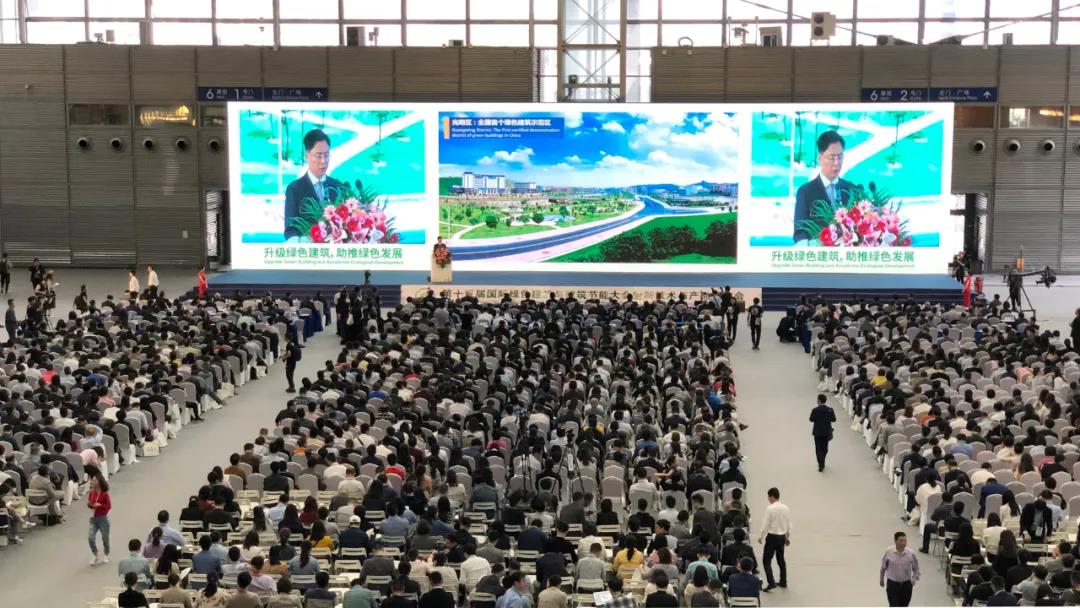
Opening of the 15th IGEBC Photo credit by @ GFHS
First of all, I want to brief you on the basics of the
IGMC Initiative and Standards.
The International Green Model City (IGMC) Initiative
was launched by Global Forum on Human Settlements (GFHS) at the headquarters of
the United Nations in April 2011. The Initiative never stops improving itself
to keep up with the times. As a UN-supported and innovative green low-carbon
action plan for urban development, the IGMC initiative motivates
forward-looking governments, businesses and the civil society to work together
in order to build sustainable cities and human settlements for all, to
facilitate transformation of Chinese cities from quantity-driven growth to
quality-oriented sustainable development and to promote the implementation of
the 2030 Agenda for Sustainable Development, the Paris Climate Agreement and
the New Urban Agenda at regional and local level.
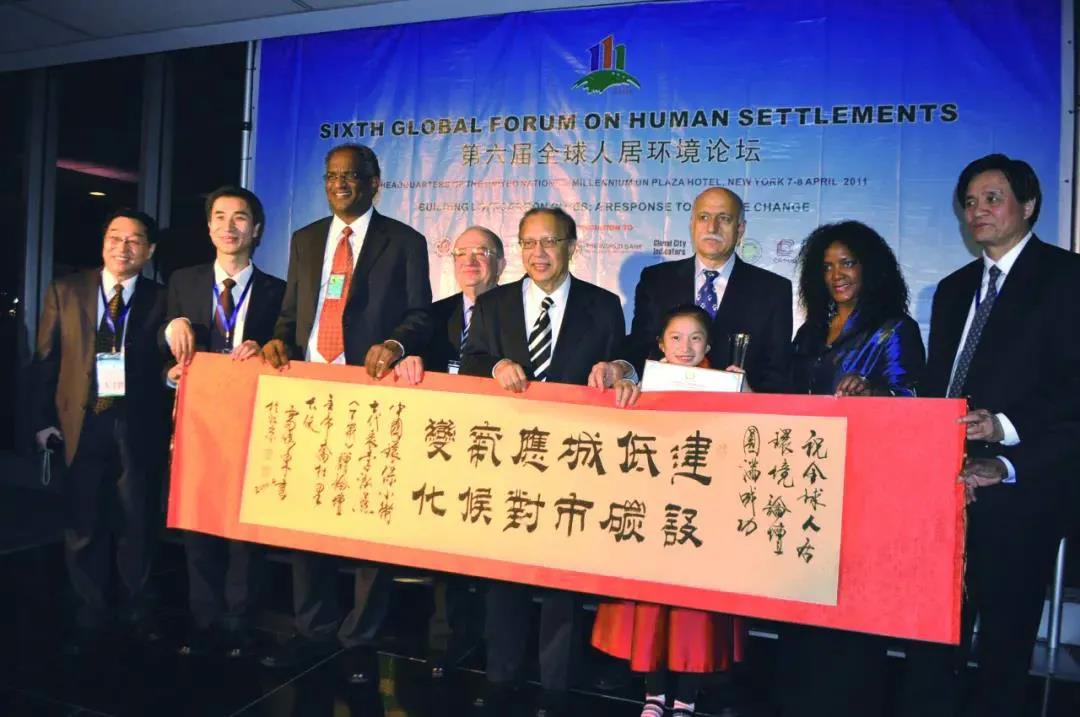
On 8th April 2011, IGMC initiative was officially launched by GFHS at the UN headquarters in New York
Photo credit by @ GFHS
The IGMC Standards 3.0, an advanced tool to assess and guide sustainable urban development, is rooted in the 2030 Agenda for Sustainable Development and the New Urban Agenda, and accords with the spirit of China’s national new urbanization planning and the Central Urban Work Conference. Its vision is based on six basic principles: Safety, Sustainability, Equity, Identity, Prosperity and Happiness, and is carried out through six dimensions of spatial planning and development, basic services, environment, economy, society and culture. Furthermore, the 18 categories are further elaborated in terms of definitions and aims, key strategies and methodologies, key indicators, scoring systems and best practices. It is written in both English and Chinese.
The IGMC Standards 3.0 is a feasible document created
by well-known experts from home and abroad on the basis of the rules and
experience drawn from many successful cases of urban planning and development
across the world, absorbing the theoretical and practical essence of
international eco-cities, Smart Growth and New Urbanism, which offers universal
guidance for reference. It was released at Habitat III which was held in Quito,
Ecuador in October 2016.
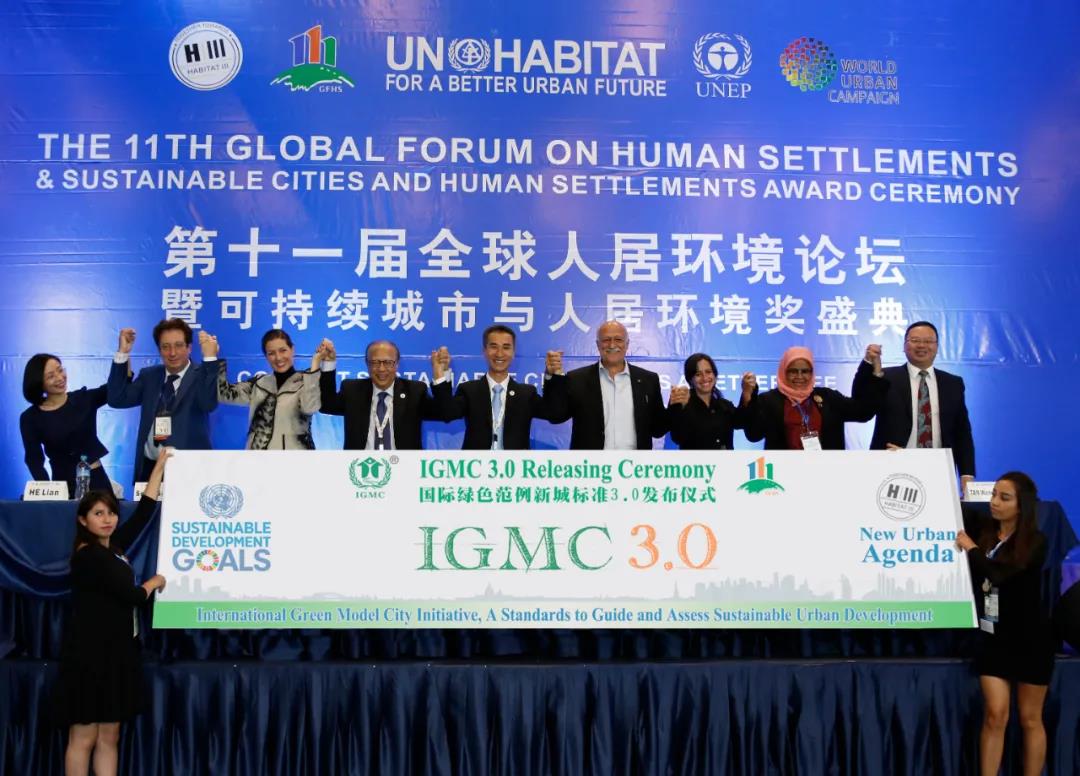
During the Habitat III in October 2016, the IGMC Standards 3.0 was released in Quito, Ecuador,
attended by UN senior officials, mayors and well-known experts. Photo credit by @ GFHS
Based on the IGMC Standards 3.0, we have developed the
IGMC global online assessment and certification system (Chinese and English
versions): www.igmci.org. The online system makes assessment and certification
easier and more accessible to everyone.
So far, more than 20 cities, zones and enterprises
across the globe have joined the IGMC Initiative, such as Vancouver (Canada),
Cape Town (South Africa), Guiyang (China), Liuyang National Economic &
Technological Development Zone, Xi’an Economic & Technological Development
Zone, Country Garden, Mission Hills and LAY-OUT Planning. Some of them have
also been on the list of IGMC pilot projects.

Next, I am going to tell you what IGMC has done over
the past year.
In terms of basic construction, kicking off in 2017,
the IGMC global online assessment and certification system and the introductory
animation film of IGMC were completed and released last year. The animation
film premiered at the UN ESCAP in Bangkok on World Cities Day last year, the
one you watched just now. Inspired by IGMC Standards 3.0, the film was produced
based on the life of the SaSa family of three who lives in a Southern Chinese
city. It displays what a future greener city should look like in terms of
ecological environment, transport and mobility, CBD, neighborhood and
smartness. The film therefore envisions a beautiful city with clean air, a well-connected
city with unimpeded traffic flow, a livable city with convenient facilities,
and a smart city filled with happiness. The online assessment and certification
system makes it more convenient to assess the sustainability performance of
cities and communities.
With regard to education, we organized the IGMC
training and held the IGMC sub-forum during the 2018 Annual Session of GFHS at
the UN Conference Center in Bangkok. In addition, on November 18th last year, I
delivered a speech entitled “The IGMC Initiative: Promote the High Quality and
Sustainable Development of Chinese Cities” at the China Urban Innovation and
Development Forum in Beijing.
For the sake of publicity, last year we signed an IGMC
strategic cooperation agreement with the Evergrande Group. On the basis of the
IGMC philosophy, LAY-OUT won the project bidding of the Xi’an Economic &
Technological Development Zone to apply the IGMC Standards to the regulation
and planning of the Auto Town in the Zone. Later, Mr. Jiang, Deputy General Manager
of LAY-OUT, will tell us about it. Last month, Mayor of Quezon, the Philippines
signed a letter of commitment to be the 13th city (zone) to join the
IGMC Initiative. Today, a few more influential planning and design enterprises
in China will join us too. This year, we will see more cities and enterprises
become a member of the IGMC family.
As regards the development of pilots, we had a lot of
discussion with the Administration Committee of the Liuyang National Economic
& Technological Development Zone about the “Assessment Report on the
Pilots’ Status” and the composition of the “Sustainable Action Planning of
Pilots”. Finally, we reached an agreement on the principles at the joint
meeting held in Changsha in May last year, and decided to implement them as
soon as possible. The work of the Liuyang National Economic & Technical
Development Zone has been covered in the issue No. 31 of World Best Practices,
and in The Almanac of China’s Cities to be published this month.
As for promotion and application, the new edition of
The Almanac of China’s Cities will publish the full text of the IGMC Standards
3.0, including the 112 indicators and the rating system. It will be the first
time for the Standards to appear in a state-level authoritative publication. Besides,
in 2019 the IGMC Standards 3.0 will begin to be used to assess cities and
communities for the Sustainable Cities and Human Settlements Award, which will
expand the applicability of the Standards. Deputy Secretary-General of GFHS He
Lian will talk about it later.
Now, I would like to share with you the background, policy and some cases
as well as my advice on the trends of urban planning and development for your
reference, which are also a lead-in for the following discussion.
As is known to us all, we are confronted with serious
challenges, such as climate change, environmental deterioration and wealth
polarization. Our citizens are plagued by loads of garbage, heavy smog,
ubiquitous sewage, traffic congestion and soaring housing price. But most
people are indifferent or even turn a blind eye to the fact that many species
are disappearing, glaciers are melting, polar bears are losing their habitat
and extreme weather is multiplying globally. I still remember that the
horrifying super typhoon Mangkhut slammed into Shenzhen last year, destroying
nearly 20,000 trees and forcing people to confine themselves indoors, who were
helpless in front of the severe rainstorm. Climate change is happening right
before our eyes at the very moment. The Paris Agreement suggests to limit
warming to 1.5 degrees because 2 degrees is still too high. The UN reported
that if warming rose from 1.5 degrees to 2 degrees, the situation would be
totally different because 99% of the coral reefs in the world would degrade
while limiting temperature rise to 1.5 degrees could avoid huge losses and
risks caused by climate change. What’s worse, eight million tons of plastic is
dumped into the ocean each year and has reached the Mariana Trench, the deepest
spot on Earth. The tiny plastic particles were sucked up by marine creatures
and were also found in human intestines, stomach and excreta. Just like PM 2.5,
they can be absorbed into our blood and even cells, which is incurable at
present.
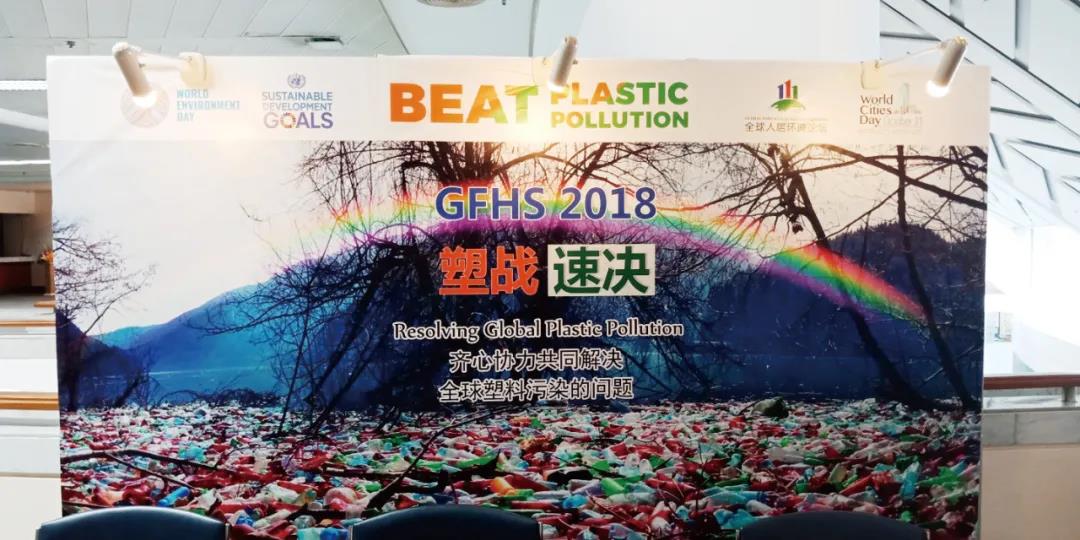
Booth of "Beat Plastic
Pollution" at the GFHS 2018, UNCC, Bangkok, Thailand
Photo credit by @ GFHS
During the UN Environment Assembly last month, the UN
Environment released the Global Environment Outlook-6, warning that the earth
had been severely damaged and the ecological system and human sustainable
development would be increasingly threatened if no emergency and stronger action
was taken. The antibiotic resistance of pollutants in fresh water systems might
be the main cause of human deaths by 2050. Endocrine disruptors will affect the
fertility of men and women and also children’s neurodevelopment. Although the
world has the science, technology and funding to move towards a more
sustainable path, the public, businesses, and political leaders have not
invested enough attention or support in these areas, and they are still
sticking to some outdated patterns of production and development.
In the face of global crisis and challenges,
international and domestic changes have been taking place. 2015 was a turning
point because the UN member states adopted the 2030 Agenda for Sustainable
Development, the Paris Agreement and the New Urban Agenda, and are determined
to implement them on a global scale. The EU put forward the target in November
last year to achieve “carbon neutrality” by 2050, while creating prosperity and
improving the quality of life.
Cities or city clusters are the main place for human
settlements and production, and also the main battlefield to fight against the
above-mentioned chronic problems. Today, the three major trends in urban
development are ""carbon-basedgreening","silicon-based
Intellectualization" and "people-based inclusiveness",which will
fully combine to reshape our cities and communities. The vision of the IGMC is
to build cities and human settlements that are characterized by “safety,
sustainability, equality, identity, prosperity and happiness”. Taking happiness
as the highest value means to follow and lead these trends of urban
development. Therefore, to implement the 2030 Agenda for Sustainable
Development, the New Urban Agenda and the Paris Agreement at the local level through
IGMC Initiative is an important way to achieve the goal of sustainable
development for all mankind, and also an indispensable part of the Chinese
dream to realize the great rejuvenation of the Chinese nation. That is the
mission and value of the IGMC Initiative and Standards.
In November 2017, the mayors of 25 cities around the
world promised in Bonn to achieve net zero carbon by 2050 in order to combat
climate change, including Ankara and Cape Town in Africa; Barcelona,
Copenhagen, Paris and London in Europe; New York, Portland, Los Angeles,
Vancouver and Quito in America and Melbourne in Australia. They cover a
population of 150 million. Besides, Vancouver and Cape Town have joined the
IGMC Initiative. We also look forward to having Chinese cities stand up and
promise to achieve net zero carbon, and the IGMC can give them support. Every
year, a number of pioneering cities and enterprises of sustainable development
attend the annual forum of GFHS and the best ones of them will receive the
“Sustainable Cities and Human Settlements Award”. Their successful experience
has inspired the industry to take action.
In China, since the 18th National People's
Congress of the CPC, ecological civilization construction has become one of the
major national policies. The 19th National People's Congress of the
CPC went further to make binding policies for achieving green, all-round and
coordinated development in production, life, environmental protection and
urban-rural planning. So we have seen a series of major reforms and new trends.
For example, multiple regulations for spacial planning of land have been
integrated as one; mountains, waters, forests, fields, grasslands and seas are
coordinated to form a systematic ecosystem; tough measures have been taken to
deal with water, land, air pollution as well as carbon emission; green economy
is growing fast and the eco-friendly life style is trendy. All these are in
accord with the international and domestic trends and situations, and in line
with people’s interests as well as future development. In December last year,
the Ministry of Housing and Urban-Rural Development published a new version of
the Green Building Evaluation Standards. The biggest change is that it requires
green building evaluation to be carried out only after the construction project
is completed, and green building certification cannot be issued just on the
basis of design drawings anymore. The theme of the IGEBC this year -- “Upgrade
Green Building and Accelerate Ecological Development”-- also revealed the trend
to be “green and greener”. Next, I will analyze three important cases:
Shenzhen, the Xiong’an New Area and the Guangdong-Hong Kong-Macau Greater Bay
Area, and then the deputy chief architect Ms. Zeng Yu will share with you the
practical exploration of new green concepts for the Beijing Sub-center. In
these cases, the planning outlines of the state-level super strategies all regard
ecological civilization, green development, intelligence and high efficiency as
the principal direction with rigid instructions. Many of their indicators and
strategies are consistent with those of the IGMC.
In February last year, the State Council approved
Shenzhen to establish the National Innovation Demonstration Zone for
Sustainable Development Agenda to strive for innovation-driven sustainable
development, forming an effective model that could be applied, duplicated and
promoted in megacities. Together with two different types of cities, Taiyuan
and Guilin, Shenzhen will provide practical experience for China to implement
the 2030 Agenda for Sustainable Development. Also, Shenzhen will continue to be
a pioneer in sustainable development to enhance its environmental quality,
inclusiveness, competitiveness and happiness index. Shenzhen’s National
Innovation Demonstration Zone for Sustainable Development Agenda totally
accords with the IGMC’s aims and strategies to implement the 2030 Agenda for
Sustainable Development at the local level, and they are complementary to each
other. But I will not elaborate on it for the sake of time.
The Xiong’an New Area is the propeller for Beijing.
The goal of its planning is to “build a high-level modern socialist city with
strong competitiveness and influence, which is green, low-carbon,
information-intelligent and livable and where man and nature coexist
harmoniously”. Obviously, green and low carbon comes first, followed by
information-intelligence. Of its 38 indicators, 25 can find their counterparts
with similar value in the IGMC indicator system. The planning for Xiong’an
proposes a number of requirements: “to adhere to the rigid constraints of
resource and environmental carrying capacity as well as water conservation” ,
which is about ecological footprints; “to pay attention to the spatial design
of neighborhoods to create a community that is friendly to all ages with
well-proportioned space and pleasant environment”, which represents the
strategies of small communities and social inclusiveness; “to ensure 100% clean
energy for end-use energy consumption”, which means the net zero carbon strategy;
“to build a three-tier neighborhood within 5, 10 and 15 minutes of walk”, which
embodies the concept of mixed-use and convenient communities; “to
scientifically design the road network’s density in the starting area at 10-15
km/km² with reasonable road width”, which is the road narrowing strategy; “to
build a slow traffic system for cyclists and pedestrians and separate them from
vehicles”, which is called the slow traffic strategy; “to increase the
percentage of green transportation in the starting area to 90%, which can keep
a majority of private cars away from the urban commute; “to maintain the
control rate of the total annual rainfall runoff in the construction area up to
85%”, which demonstrates the strategies of green infrastructure and sponge cities;
“to realize zero landfill of primary garbage”, which is called the zero garbage
strategy. These concepts and strategies are also strongly advocated by the IGMC
because they are people-oriented instead of capital-based.
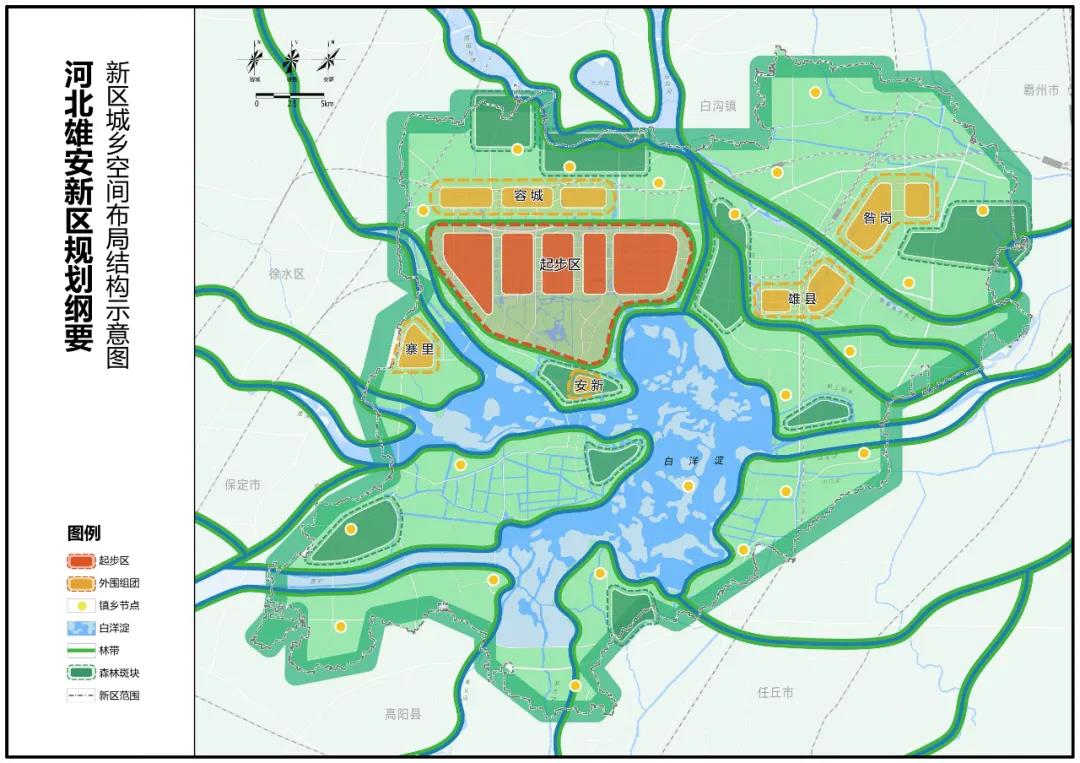
Schematic diagram of urban and rural spatial
layout structure of Xiong'an New Area, Hebei Province
Photo credit by @ Xiong’an New
Area official website
The Guangdong-Hong Kong-Macao Greater Bay Area
Development Plan aims at “building a first-class bay area and a world-class
city cluster with dynamism and international competitiveness to create a model
of high-quality development.” The fundamental principle of the Plan calls for
“carrying out a most stringent system to protect the ecological environment, to
preserve farmland and to save land resources, promoting a green and low-carbon
mode of production, living as well as urban construction and operation, and
creating an excellent ecological environment for residents, so as to facilitate
the sustainable development of the Greater Bay Area. That shows the great
determination of the Plan. The strategic positioning of the Greater Bay Area is
to build “a quality circle for life, business and tourism, with quality life as
its strategic goal. The development goal of the Area is to “basically establish
a green and low-carbon mode of production, living as well as urban construction
and operation so that residents can live a more convenient and happier life”,
emphasizing that “urban construction and operation should be green,
intelligent, energy-efficient and low-carbon. There are few other places in
China to view happiness as one of their development goals. The Plan is also
ambitious to “build a smart city cluster” and “explore a development mode for
future cities”. The seventh chapter of the Plan is very informative about
ecological civilization construction, involving the prevention and treatment of
water, air and land pollution, the coordination of land and ocean as well as
food and human settlement safety. To tackle climate change, we should
“implement the demonstration project of near-zero carbon emission zones,
struggle to achieve the carbon emission peak and establish a demonstration zone
of green development”. The concept of near-zero emissions now has been
introduced though it was unbelievable a few years ago. In terms of resource
recycling, extended producer responsibility is applied. Manufacturers should
take responsibility for the whole life cycle of their products, so any costs of
environmental resources will be added to the product costs, which will be paid
by producers and consumers. These are all the directions for building a
quality, green and happy bay area.


The poem Green Cities Resemble Trees was
displayed through a Chinese calligraphy work
at the GFHS 2018, UNCC, Bangkok,
Thailand Photo credit by @ GFHS
Before my conclusion,I think of a metaphor: the future green cities resemble trees,which has the following five advantages to learn from:
1. Best technology with photosynthetic energy: By absorbing solar energy through photosynthesis, it provides the high-quality renewable energy in a simple, efficient and continuous way;
2. Environmentally-friendly by sequestrating carbon and releasing oxygen: It offers refreshable breathing for life, purifies air quality, and helps to control atmospheric carbon dioxide concentration;
3. Circulating resources without making any waste: It is good at synthesizing organic matter, recycling water and nutrient, keeping ecological balance, and making life go onward in an endless succession;
4. Even interconnection in the leaf vein network: Reaching a single target through multiple paths, it provides a flexible urban traffic network mode;
5. Inclusive and equitable: Every leaf has equal opportunities to access resources,it can matter-of-factly realize the goal of leaving no one behind.
Based on this, I composed a poem called "Green Cities Resemble
Trees", which I would like to share with you:
Green Cities Resemble Trees
Gracefully erect, the trees are towering,
Like Tao that closely follows nature.
Uninterruptedly from them energy is emanating,
For daylight provides the source of power.
Blessedly rained and dewed, they thus tend to cultivate,
In a robust cycle they turn over and over again.
They oblige loads of carbon to sequestrate,
While nursing numerous breathing lungs with fresh oxygen.
The leaf vein network is balanceable level,
Reaching each cell through every different way.
Happily it conveys synergy from petal to petal,
And ushers rustling wind to merrily stay.
As long as Green Cities resemble trees,
The world will teem with happiness forever.

Contributed by Lu Haifeng, Secretary General, Global Forum on Human Settlements (GFHS) (in 2019)
Copyright © Global Forum on Human Settlements (GFHS)
